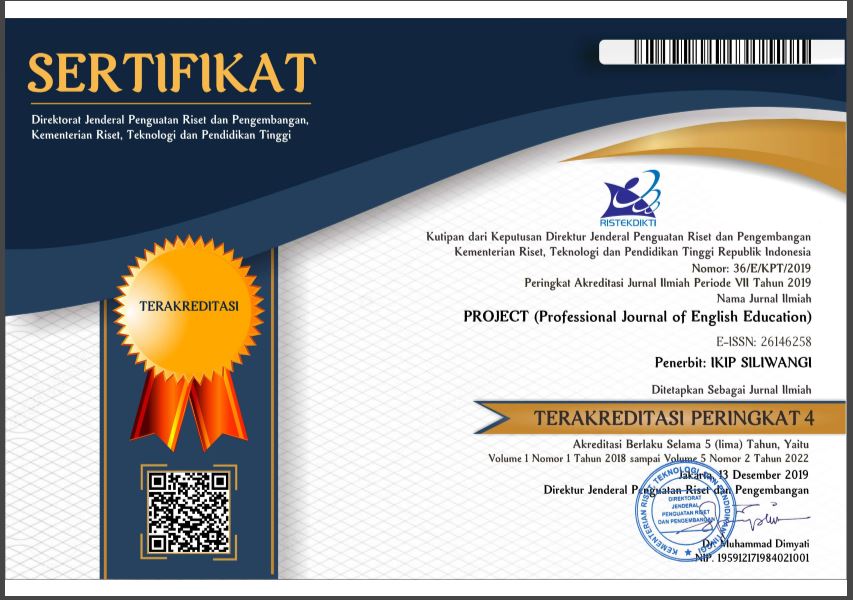HOW DO READING MOTIVATION AND STORYTELLING TECHNIQUE AFFECT STUDENTS’ COMPREHENSION OF READING AT SMA N 1 SEMENDE DARAT LAUT
Abstract
This article aims to look at: (1) the differences that occur between reading motivation and storytelling techniques on students' reading comprehension, and (2) the interactions that occur between the independent variables, moderator variables and dependent variables. In this study used descriptive techniques using descriptive analysis methods to analyze the data, where the data obtained will be analyzed in the form of words or numbers. This study used 33 class XI students of SMA Negeri 1 Semende Darat Laut as respondents. From the research findings, there is a difference between variable X1 Motivation to Read and Variable X2 storytelling technique towards the variable y reading comprehension, and there has been a significant interaction between the variables in the research. based on these findings the researcher can draw conclusions from this analysis, as follows: Students' reading comprehension is influenced by storytelling strategies and reading motivation.
References
Al-Mansour, N. S., & Al-Shorman, R. A. (2010). The effect of teacher’s storytelling aloud on the reading comprehension of Saudi elementary stage students. Journal of King Saud University - Languages and Translation, 23(2), 69–76. https://doi.org/10.1016/j.jksult.2011.04.001
Brown, H.-D. (2007). Learner Principles of Language Learning and Teaching. In Encyclopedia of the Sciences of Learning. https://doi.org/10.1007/978-1-4419-1428-6_347
Cline, F., Johnstone, C., & King, T. (2006). Focus Group Reactions to Three Definitions of Reading (As Originally Developed in Support of NARAP Goal 1). Minneapolis, MN: National Accessible Reading Assessment Projects, 1(1), 9. https://files.eric.ed.gov/fulltext/ED506575.pdf
Duke, N., Pearson, D., Strachan, S., & Billman, A. (2011). Essential Elements of Fostering and Teaching Reading Comprehension. What Research Has to Say About Reading Instruction, 51–93. https://doi.org/10.1598/0829.03
Fraenkel, J. R., Wallen, N. E., & Hyun, H. H. (2012). How to design and evaluate research in education (Eighth). McGraw-Hill, a business unit of The McGraw-Hill Companies, Inc. https://saochhengpheng.files.wordpress.com/2017/03/jack_fraenkel_norman_wallen_helen_hyun-how_to_design_and_evaluate_research_in_education_8th_edition_-mcgraw-hill_humanities_social_sciences_languages2011.pdf
Guthrie, J. T., Van Meter, P., McCann, A. D., & Wigfield, A. (1996). Growth of literacy engagement: Changes in motivations and strategies during conceptoriented reading instruction. Reading Research Quarterly, 31, 306–332. http://doi.org/10.1598/RRQ.31.3.5
Guthrie, J. T., Wigfield, A., & VonSecker, C. (2000). Effects of integrated instruction on motivation and strategy use in reading. Journal of Educational Psychology, 92(2), 331–341. https://doi.org/10.1037/0022-0663.92.2.331
Halstead, J. M., & Taylor, M. J. (2000). Learning and Teaching about Values: A review of recent research. Cambridge Journal of Education, 30(2), 169–202. https://doi.org/10.1080/713657146
Hatam, W. R., Sudibyo, D., & Wibowo, A. (2018). The Effecriveness of Storytelling Strategy to Improve Students' Reading Comprehension at Second Grades of MTs Al-Ma'Arif 1 Kabupaten Sorong. INTERACTION: Jurnal Pendidikan Bahasa, 5(2), 58–67. https://doi.org/10.36232/jurnalpendidikanbahasa.v5i2.182
Kuşdemir, Y., & Bulut, P. (2018). The Relationship between Elementary School Students’ Reading Comprehension and Reading Motivation. Journal of Education and Training Studies, 6(12), 97. https://doi.org/10.11114/jets.v6i12.3595
Mallan, K. M. (1991). Children as Storytellers. Primary English Teaching Association. https://doi.org/https://orcid.org/0000-0001-8915-1080
McDrury, J. & A. M. (2004). Learning through storytelling: Using reflection and experience in higher education context (first). Taylor & Francis e-Library. https://www.taylorfrancis.com/books/mono/10.4324/9780203416655/learning-storytelling-higher-education-maxine-alterio-janice-mcdrury
Myers, D. G. (2010). Social Psychology. In The Journal of nutrition (tenth, Vol. 24). McGraw-Hill, a business unit of The McGraw-Hill Companies, Inc. https://diasmumpuni.files.wordpress.com/2018/02/david_g-_myers_social_psychology_10th_editionbookfi.pdf
Patel, M. F., & Jain, P. M. (2008). English language teaching (Methods, Tools, & Technique). In Year’s Work in English Studies (First, Vol. 36, Issue 1). Sunrise Publishers & Distributors. https://doi.org/10.1093/ywes/XXXVI.1.44
Pintrich, P. R. (2003). A motivational science perspective on the role of student motivation in learning and teaching contexts. Journal of Educational Psychology, 95, 667–686.
Rumelhart, D. E., & Zipser, D. (1985). Feature discovery by competitive learning. Cognitive Science, 9(1), 75–112. https://doi.org/10.1016/S0364-0213(85)80010-0
Samantaray, P. (2014). Use of Story Telling Method to Develop Spoken English Skill. International Journal of Language & Linguistics, 1(1), 40–44. www.ijllnet.com
Taboada, A., & Buehl, M. M. (2012). Teachers conceptions of reading comprehension and motivation to read. Teachers and Teaching: Theory and Practice, 18(1), 101–122. https://doi.org/10.1080/13540602.2011.622559
Downloads
Published
Issue
Section
License
Copyright (c) 2023 PROJECT (Professional Journal of English Education)

This work is licensed under a Creative Commons Attribution-ShareAlike 4.0 International License.




